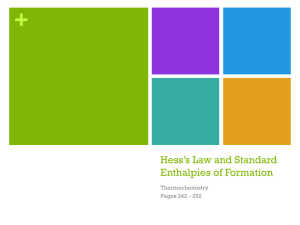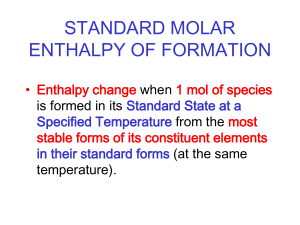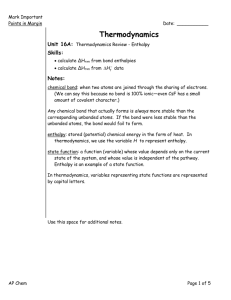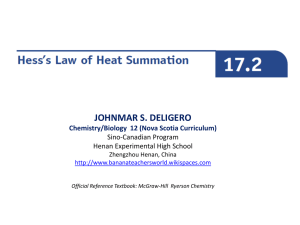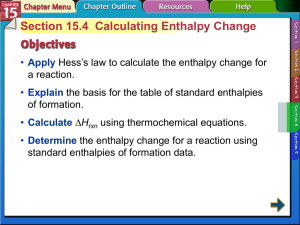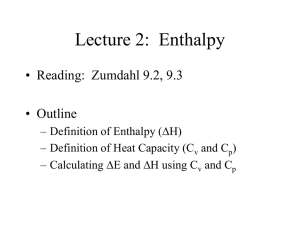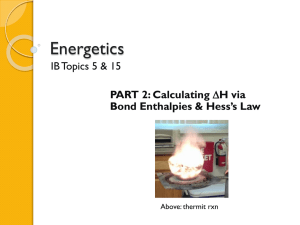Hess`s Law PPT
advertisement
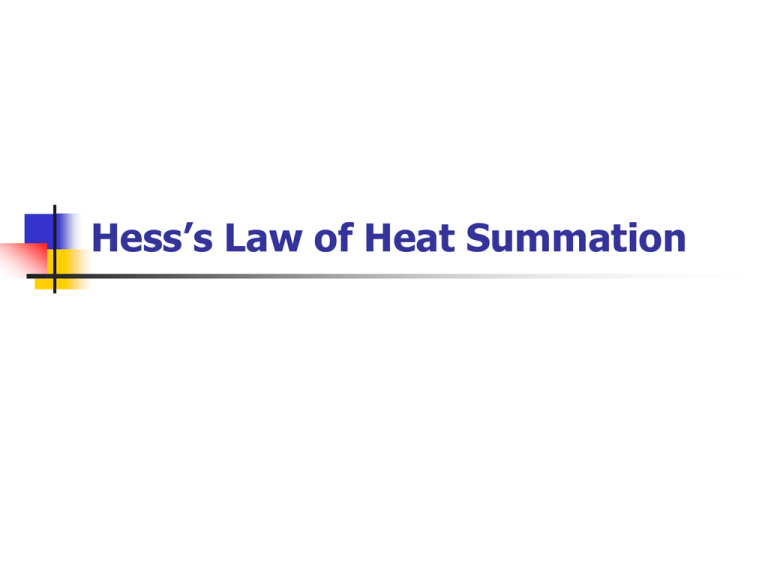
Hess’s Law of Heat Summation Hess’s law Chemists can determine the enthalpy change of any reaction using an important law, known as Hess’s law of heat summation. The enthalpy change of a physical or chemical process depends only on the beginning conditions (reactants) and the end conditions (products). The enthalpy change is independent of the pathway of the process and the number of intermediate steps in the process. It is the sum of the enthalpy changes of all the individual steps that make up the process. Hess’s Law For example, carbon and oxygen can form carbon dioxide via two pathways. 1. Carbon can react with oxygen to form carbon monoxide. The carbon monoxide then reacts with oxygen to produce carbon dioxide. The two equations below represent this pathway. C(s) + 12O2(g) → CO(g) ΔH° = −110.5 kJ/mol CO(g) + 12O2(g) → CO2(g) ΔH° = −283.0 kJ/mol 2. Carbon can also react with oxygen to produce carbon dioxide directly. C(s) + O2(g) → CO2(g) ΔH° = −393.5 kJ/mol In both cases, the net result is that one mole of carbon reacts with one mole of oxygen to produce one mole of carbon dioxide. Hess’s Law Representing pathways using an enthalpy diagram. Hess’s law allows you to determine the energy of a chemical reaction without directly measuring it. Use Hess’s law to calculate the enthalpy change of a chemical reaction: 1. by combining chemical equations algebraically 2. by using the enthalpy of formation Hess’s Law According to Hess’s law, the pathway that is taken in a chemical reaction has no effect on the enthalpy change of the reaction. One way is to add equations for reactions with known enthalpy changes, so that their net result is the reaction you are interested in. Hess’s Law For example, you can combine thermochemical equations (1) and (2) below to find the enthalpy change for the decomposition of hydrogen peroxide, equation (3). (1) H2O2(l) → H2(g) + O2(g) (2) H2(g) + 12O2(g) → H2O(l) (3) H2O2(l) → H2O(l) + 12O2(g) ΔH° = +188 kJ/mol ΔH° = −286 kJ/mol ΔH° = ? Hess’s Law Hess’s Law 1. 2. In many cases, however, you will need to manipulate the equations before adding them. There are two key ways in which you can manipulate an equation: Reverse an equation so that the products become reactants and the reactants become products. When you reverse an equation, you need to change the sign of ΔH° (multiply by −1). Multiply each coefficient in an equation by the same integer or fraction. When you multiply an equation, you need to multiply ΔH° by the same number. Hess’s Law Practice P 681 #11-14 Using Standard Molar Enthalpies of Formation the following equation shows the formation of liquid water from its elements under standard conditions. H2(g) + 12O2(g) → H2O(l) ΔH°f = −285.8 kJ/mol Practice P 685 #15-18 Calculating Enthalpy Changes You can calculate the enthalpy change of a chemical reaction by adding the heats of formation of the products and subtracting the heats of formation of the reactants. ΔH°rxn = Σ(nΔH°f products) − Σ(nΔH°f reactants) In this equation, n represents the molar coefficient of each compound in the balanced chemical equation and Σ means “the sum of.” CH4(g) + 2O2(g) → CO2(g) + 2H2O(g) ΔH°rxn = [(ΔH°f of CO2(g)) + 2(ΔH°f of H2O(g))] − [(ΔH°f of CH4(g)) + 2(ΔH°f of O2(g))] ΔH°rxn = [(−393.5 kJ/mol) + 2(−241.8 kJ/mol)] − [(−74.8 kJ/mol) + 2(0 kJ/mol)] = −802.3 kJ/mol of CH4 Use heats of formation to find heat of reaction solution Practice P 687 #19-22 Using Bond Energies Breaking bonds is an exothermic process, while making bonds is an endothermic process. A specific amount of energy is needed to break each type of bond-- bond energy Bond energy is usually measured in kJ/mol. Bond Energies Every chemical reaction involves bond breaking and bond formation. Since there are different types of bonds in the reactants and products, the total energy required for bond breaking and the total energy released when new bonds form are different. The difference represents the energy change for the reaction. Bond Energies To use bond energies to estimate the enthalpy change for a reaction: add together the total bond energies of the reactants. Bond breakage requires energy, so the sign will be positive. From the total, subtract the total bond energies of the products. Bond energies Since bond energies are only a way of estimating the energy of a reaction, your answer will not agree exactly with the recognized enthalpy of reaction. Bond energies are not exact; rather, they are averages. Practice P 690 #23-26 Section Review: At this point you should be able to answer p 691 # 1,3-7
